Home > Auctions > 5 - 9 December 2023
Ancient Art, Antiquities, Natural History & Coins
Auction Highlights:
Acquired 1980-2015.
Ex Abelita family collection.
See Khorasani, M.M., Arms and Armour from Iran. The Bronze Age to the End of the Qajar Period, Tübingen, 2006, figures 467 and 470, for some of these types.
Some of these arrowheads seem to belong to the type V, subcategory types A and C according to the classification of Khorasani and Negahban. In the four categories of triangular bronze arrowheads from Luristan, Marlik and Northern Iran described by Negahban, subtypes A and C of type V are larger arrow heads with barbed shoulders and triangular heads. These types of arrowheads were commonly used in Anatolia and Mesopotamia from the 2nd millennium B.C., but apparently their employment began earlier in this area, where types like these occur alongside the non-barbed, predominantly ribbed and tanged types.
Ex private collection of Mr M.B., Mainz, Germany, since the 1980s.
Acquired from the above, 2004.
Cf. D'Amato, R., 'The Betrayal: military iconography and archaeology in the Byzantine paintings of XI-XV centuries AD representing the arrest of Our Lord' in Acts of the International conference ‘Weapons bring peace? Warfare in Medieval and Early Modern Europe’, Wroclaw, 2-4 December 2010, Wroclaw, 2012, pp.69-95, fig.18; Hjardar, K. and Vike, V., Vikings at war, Oxford-Philadelphia, 2016, pp.175-180.
This type of spears account for half of the found Viking spears, together with types I,K,G,F. Differently from the previous types of Viking spearheads, side wings do not feature commonly in these typologies. A Viking spear of M type, dated at end of 11th century A.D., was found on the Drastar battlefield, showing a cross intermediary between the blade and the shaft.
Ex Axel Guttmann Collection of Ancient Arms and Armour, Germany [1944-2001].
with Hermann Historica, 13 October 2010, lot 2169 [Part].
Cf. Waurick, G., 'Der Pilos-Typ' in Antike Helme, RGZM Monographien 14, Mainz, 1988, pp.151-158, spec. no.K48, p.437; Connolly, P., Greece and Rome at war, London, 1981, pp.66,70; Sekunda, N., The ancient Greeks, Armies of Classical Greece 5th and 4th centuries BC, London, 1986, pp.25-26, 30-31, 47-48, 56-57, pls.F,G,H; Hixenbaugh, R., Ancient Greek Helmets, a complete guide and catalogue, New York, 2019, figs.H185ff.
This type of helmet (called ‘bell-helmet’ by Connolly, 1981, p.70), named pilos after the Greek felt cap (in the Laconian shape, but distinguished from the cap by the noticeable point and the shape of the rim), had a conical shape and was pointed or rounded at the top. Its introduction was linked with the streamlining of Hoplite equipment, and it soon the replaced the closed Corinthian helmet. The helmet was widespread in the Greek and Mediterranean world from the last quarter of the 5th century B.C. and was widely used by continental Greeks, South Italian Greeks and Italic people, Etruscans, and even Romans.
Found Northern Europe.
UK private collection.
Acquired from Redhouse Antiques Centre, York, 2005.
Property of a Nottinghamshire gentleman.
Cf. Bishop, M.C. & Coulston, J.C.N., Roman military equipment, from the Punic wars to the fall of Rome, London, 2006, p.101, fig.58 (manica from Carlisle); fig.86 (manicae from Newstead and Carnuntum); D'Amato,R., Negin, A., Roman Heavy Cavalry (1), Cataphractarii & Clibanarii, 1st century BC-5th Century AD, Oxford, 2018, pp.38-39 (samples of limb armour from Dura Europos,Pochlarn and Siena Private Collection, the last presumably from the Danube).
On the Adamclisi monument, at least thirteen Roman legionaries and three standard-bearers have the right arm covered by an armoured sleeve (manica). It is likely that this laminated protection of the arm, derived from that worn by the gladiators, was introduced in the Imperial army in the early first century A.D., and extended to the legionaries fighting during the Dacian Wars. Domitian’s militia had already experienced the importance of protecting the arms from enemy falces. Modern scholars however do not consider this the only and exclusive reason for the introduction of this part of equipment to the Roman army between 21 and 70 A.D. The armoured sleeve can often be seen on weaponry trophies of 1st century A.D., not only on those linked with the revolt of Sacrovir, like that of Scafa, but also those related to the civil wars, like the armoury assemblage of Split, where the manica is even furnished with laminated gauntlet. This combat item can also be seen on legionary tombstones like those of Sextus Valerus Severus and Gaius Annius Salutus, both from Mainz; and legionaries of Legio XXII Primigenia, who were based in Mogontiacum between 43-70 A.D. Their tombstones show manicae as part of the decorative edge of weaponry surrounding the inscription of the tombstone. Severus' manica shows eleven plates and a hand shaped section of four plates. As suggested by Paul Brown all this clearly places the manica as being used by Roman legions around 21-70 A.D., with a widespread use throughout the empire at the time of the Dacian Wars. In the following period its use continued: a monument of Legio XIII Gemina, from Apulum (now Alba Julia) still shows a legionary of early third century in lorica segmentata combined with a manica like his predecessors of Adamclisi. Several specimens have been found in all the territories of the Empire, especially in England (Carlisle, Newstead), Austria (Carnuntum), Spain (Santa Marina de Leon), and of course in Romania (Ulpia Sarmizegetusa Trajan). However, we cannot exclude that our fragments are related to the limb armour of Roman heavy cavalryman, the cataphractarius or clibanarius. The peculiarity of the pieces is that they had rounded edges, and were certainly fixed to a leather backing. Also Ammianus (XVI,8) speaks about the lamminarum circuli (circles of laminated sheets) protecting the Roman heavy cavalrymen of the Imperial Guard.
Acquired in the 1980s-1990s.
Property of a Nottinghamshire gentleman.
From an old London, UK, collection.
Ex London, UK, gallery.
Cf. Moorey, P.R.S., 'The Art of Ancient Iran', in Ancient Bronzes, Ceramics and Seals, Los Angeles, 1981, items 150-3; British Museum accession no.134746, in Curtis, J.E. & Tallis, N., The Horse from Arabia to Ascot, London, 2012, p.98, cat.25, for the type.
The most admirable horse bits ever created by man are undoubtedly those from Luristan, a province in the north-west of Iran which extended along the valleys that make up the central part of the Zagros mountains. Worked in cast bronze with the lost wax process, they almost always had a rigid cannon in round or square bars which were flattened and rolled up around themselves at the ends, but their exceptional feature were the figural side bars. The local metalsmiths, in a period of time between 1200 and 700 B.C. managed to create an infinite number of typologies: horses, oxen, ibex, roosters and various mythological animals.
Acquired 1980-2015.
Ex Abelita family collection.
See Christie's, Axel Guttmann collection of Ancient Arms and Armour, Part 2, London, South Kensington, Wednesday 28 April 2004, for a similar dagger (lot 21, p.22).
The techniques used by Luristan craftsmen to create bronze weapons were highly sophisticated. They used a wide variety of surface finishes: repoussé work, chasing and engraving. The fact that the mountains of Luristan were particularly rich in copper and tin, both required for making bronze, was a significant advantage to the metalworking industry. The weapons produced developed into a plethora of different forms in the 2nd millennium B.C. to at least 800 B.C. These objects include axes and adzes, pick axes, daggers and dirks, spears, swords, helmets and shields. Weapons were usually cast, but armour parts were also made by the hammering process.
Acquired 1990s-early 2000s.
East Anglian private collection.
The axe corresponds to the Maxwell-Hyslop Type 20A, similar to specimens from Ordu and purely Asiatic in inspiration. An axe from Giyan has a distinct shaft tube which is not present on the Ordu axe, but the shape of the blade is similar and it is probable that smiths travelling over the Eastern Anatolian and Persian trade routes were responsible for making these typologies of axes.
Acquired in the 1980s-1990s.
Ex an important central London gallery, London W1.
Cf. Daim, F., Hunnen + Awaren, Reitervölker aus dem Osten, Burgenländische Landesausstellung 1996, Schloß Halbturn, 26 April - 31 Oktober 1996, Eisenstadt, 1996, p.398, nos.5.365-5.367, for similar belt fittings.
This type of belt element, decorated with granulation, is present in the Avar graves of the second half of the 7th century, and was most likely produced in the workshops of the Eastern Roman Empire, from where they reached the Avar lands as imperial gifts (tomb of Kunbàboni) or spoils of war. They were part of multiple belts, to which sabres and knives were attached, commonly used among Avars, Bulgars and Romans during the 7th and 8th centuries A.D.
Acquired in the 1970s.
Ex collection of a London gentleman.
See Nicolle, D., Armies of the Ottoman Empire 1775-1820, London, 1998; Tirri, A.C., Islamic Weapons: Maghrib to Moghul, Indigo, 2003.
The yatagan is a long knife or short sabre that lacks a guard for the hand at the juncture of blade and hilt, and that usually has a double-curve to the edge and an almost straight back. It was one of the favoured side-arms of the Janissary infantry regiments. Yatagans were carried by the Zeibeks, who lived on the Ionian coast, around Smyrna.
Acquired 1960s-1990s.
Late Alison Barker collection, a retired London barrister.
Cf. Tarassuk, L. & Blair, C., Complete Encyclopaedia of Arms & Weapons, London, 1982, p.156, item 5, for a late 15th century version of the type.
The term 'ballock dagger' was used in medieval times to describe a dagger with a grip bearing a considerable resemblance to a phallic symbol. It was also called 'kidney dagger' during the Victorian times. The constant characteristic is the presence of two roundish and symmetrical bulbs at the guard, with the grip itself emerging upward between them and flaring slightly towards the top, sometimes being surmounted by a cap.
Acquired 1980-2015.
Ex Abelita family collection.
See Gorelik, M., Weapons of Ancient East, IV millennium BC-IV century BC, Saint Petersburg (2003), pl.XXII, nos.30,39 (Artik and Nalchik, in Caucasus), for similar.
In the 2nd millennium B.C., in the Caucasus area, variants of axes with a curved horizontal blade and a tubular eye developed. The simplest variants of these types were borrowed through the north of Ciscaucasia by the inhabitants of the Eurasian steppes. In the steppes, war axes became, around the middle of the 2nd millennium B.C., the most powerful bronze weapons, spreading far to the east.
841 - 852 of 2409 LOTS

.jpg)


.jpg)

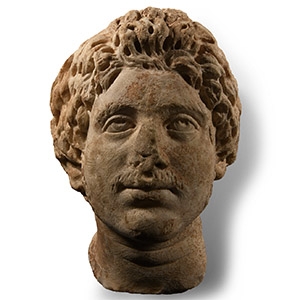
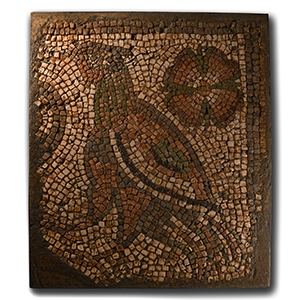
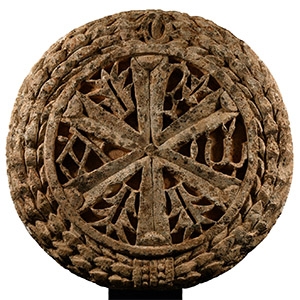


.jpg)


.jpg)
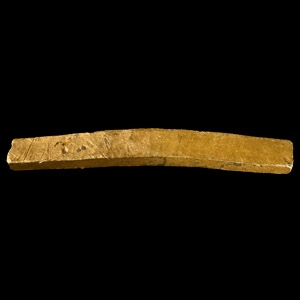
.jpg)
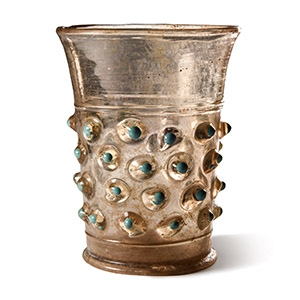

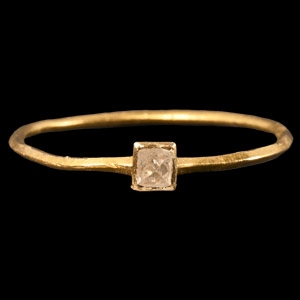

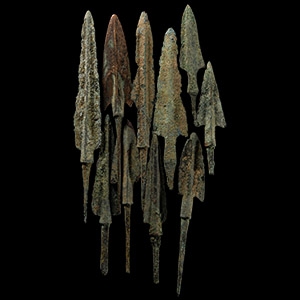
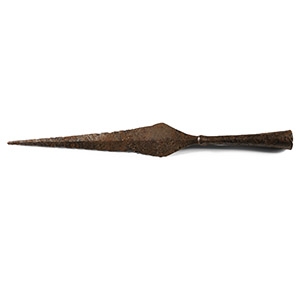
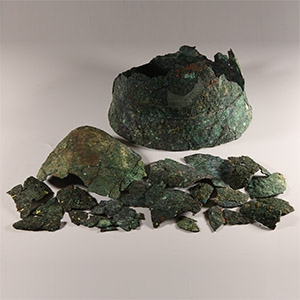
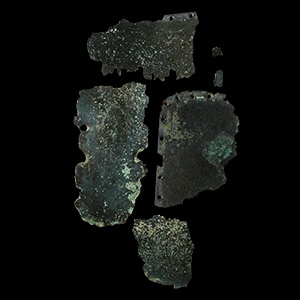
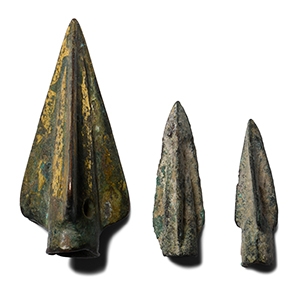

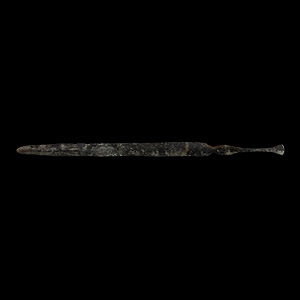


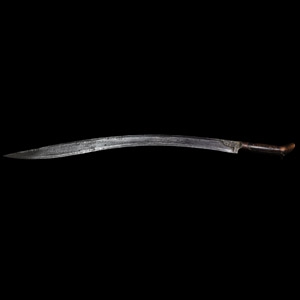
.jpg)




